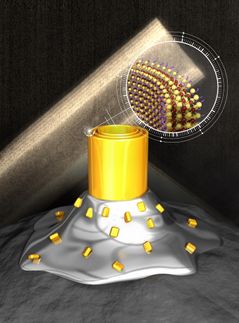Zinc stannate nanostructures: growing a highly useful semiconductor
Advertisement
Binary semiconducting oxide nanostructures, such as zinc oxide and titanium oxide, are widely used in sensors and catalysts. However, ternary semiconducting oxide nanostructures, which show higher electrical conductivity and are more stable than the binary type, are increasingly in demand for specific applications due to their particular physical properties. In contrast to conventional ‘top-down’ processes involving physically breaking large macroscopic materials into nanoparticles, the chemically based ‘self-organization’ approach offers an inexpensive and flexible means of precisely controlling the size, crystal structure and optoelectronic properties of semiconducting oxide nanostructures, which is crucial for the use of ZTO in specific applications.
ZTO nanostructures can be produced using a variety of methods including thermal evaporation, high-temperature calcination, mechanical grinding, sol-gel synthesis, hydrothermal reaction, and ion-exchange reaction. Different methods produce different ratios of ZTO oxides and impurities, expressed in alternative crystal structures. The authors describe the pertinent features of the hydrothermal growth method for synthesizing ZTO, including high purity of the stable zinc orthostannate Zn2SnO4 and the accompanying ‘cubic spinel’ crystal structure. Moreover, hydrothermal growth is an attractive and relatively simple method since crystal growth occurs at mild temperatures in water.
Typical hydrothermal growth of ZTO nanostructures consists of using an aqueous mixture of a zinc salt, such as zinc nitrate or zinc chloride, and stannic chloride. This mixture is then reduced at 200-250 °C in sodium hydroxide or ammonium hydroxide in a high-pressure environment. Various methods for hydrothermal growth of ZTO nanostructures are detailed by the authors, with varying end products in terms of crystal structure and ‘phase composition’ – amounts of the particular oxides produced.
The physical properties of ZTO depend on the method used for their synthesis. ZTO is a ‘wide-gap’ semiconductor with a bandgap of around 3.6 eV, but the precise bandgap energy depends on the conditions of synthesis, which might result in quantum confinement effects arising from the small size of the nanostructures. Controlling the photoelectrochemical properties of ZTO has practical importance, and relating the optical and electronic properties of ZTO with the composition and crystal structure can pave the way for applications of other complex oxides.
The authors describe industrial applications arising from the photoelectrochemical properties of ZTO. Firstly, as a photocatalyst ZTO can be used for degrading harmful pesticides from ground water; secondly the porous nanostructures are ideal for gas sensing as they offer high surface to volume ratios; and thirdly ZTO has potential in the field of dye-sensitized solar cells, an economically plausible alternative to conventional solar cells. Given that only a few morphologies have been reported, the authors conjecture that within the next decade ZTO nanostructures will find uses in further industrial applications.
Original publication
Sunandan Baruah and Joydeep Dutta, "Zinc stannate nanostructures: hydrothermal synthesis."; Sci. Technol. Adv. Mater.12 (2011) 013004




























































